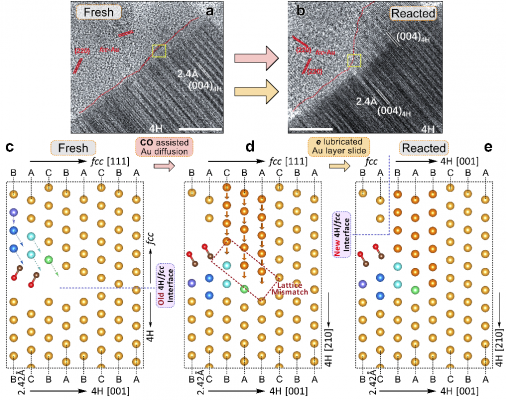New research out of Shenzhen is using a revolutionary technique to improve a wide range of green technologies such as hydrogen production, selective hydrogen peroxide reduction, and carbon dioxide reduction.
On January 28, the high-impact academic journal Nature Communications (IF = 11.878) published an interdisciplinary paper from Southern University of Science and Technology (SUSTech). Associate Professors Meng Gu (Materials Science and Engineering – MSE) and Yang-Gang Wang(Chemistry) combined their research team to publish the article titled, “Gas-assisted transformation of gold from fcc to the metastable 4H phase.”
Considerable research has been conducted into the use of manufactured nanocrystals for catalysis. These nanocrystals can be any size or shape and often use specific metal atoms to achieve the desired outcome. However, getting these metal atoms to their metal-stable form has long been a challenge, as they tend to crystallize at their lowest energy structure.

By employing in situ transmission electron microscopy(TEM) and ab initio molecular dynamics simulations, the researchers demonstrated a solid-state fcc-to-4H phase transformation through epitaxial growth of fcc-Au nanoparticles on a 4H-Au nanorod template. It was activated by a high energy electron beam and carbon monoxide (CO) gas. Their work showed that the combination of gas-metal atom interactions and the electron beam could cause the phase transformation of precious metals in local nanoscale regions. They have also demonstrated that certain rare crystal phases of metals (like the 4H phase) can be fabricated under this template in a gas environment.

The researchers will continue to explore this work for future devices and catalysis.
Shaobo Han, Guangjie Xia, and Chao Cai were co-first authors. MSE Associate Professor Meng Gu and Chemistry Associate Professor Yang-Gang Wang were the correspondent authors.
This work received support from the National Natural Science Foundation of China, Shenzhen DRC project, Guangdong Innovative and Entrepreneurial Research Team Program, Shenzhen Peacock Plan, and Shenzhen Clean Energy Research Institute. The calculations were performed on the Taiyi high-performance supercomputer cluster, supported by the Center for Computational Science and Engineering at SUSTech.
Article link: https://www.nature.com/articles/s41467-019-14212-z






